2. 中国地质科学院地质研究所, 自然资源部深地动力学重点实验室, 北京 100037;
3. 重庆市地质矿产勘查开发局川东南地质大队, 重庆 400038;
4. 中国地质大学(北京), 北京 100083
2. MNR Key Laboratory of Deep-Earth Dynamics, Institute of Geology, Chinese Academy of Geological Sciences, Beijing 100037, China;
3. Southeast Sichuan Geological Team, Chongqing Municipal Bureau of Geology and Mineral Exploration and Development, Chongqing 400038, China;
4. China University of Geosciences, Beijing 100083, China
作为岩浆演化过程晚期的结晶产物,高分异花岗岩往往经历了较为强烈的岩浆分离结晶作用,在矿物组合上以较低暗色矿物含量和较高的石英及长石含量为主要特征(Tao et al., 2013),而岩浆演化过程中的分离结晶作用在岩浆W-Sn-Nb-Ta元素的富集中起了重要作用(Jiang et al., 2016),因此高分异花岗岩具有其特殊的成矿专属性,并因此受到广泛关注(吴福元等, 2007a, 2015; Li et al., 2007; Liu et al., 2016)。现有研究表明,一些矿床如我国的华南、藏南以及欧洲的华力西造山带等地区分布的W-Sn-Nb-Ta、REE和Li-Be等矿床均被认为与高分异花岗岩具有成因上的关联(Yin et al., 1995; Marignac and Cuney, 1999; Zhu et al., 2001; Wu et al., 2017)。因此,高分异花岗岩的识别和成因研究可以为深化相关矿床研究提供直接的依据。
青藏高原自古生代以来经历了复杂的多地块拼贴历史,并被认为与不同时期的特提斯洋闭合及两侧地块的碰撞有关,漫长的地质演化历史为诸多矿床提供了良好的成矿条件(Yin and Harrison, 2000; Metcalfe, 2011, 2013; Xu et al., 2015)。班公湖-怒江结合带(后简称班-怒带)是青藏高原内一条重要缝合带,记录了班公湖-怒江特提斯洋(后简称班-怒洋)在中生代期间的打开及闭合事件,并因带内多龙矿集区、尕尔穷-嘎拉勒铜金矿床和舍索-雄梅铜矿化带的发现而受到广泛关注(宋扬等, 2014及其文献, 2019; Li et al., 2017a)。班-怒带两侧的南羌塘、北拉萨地块中发育了大量白垩纪花岗岩浆作用(潘桂棠等, 2006; 朱弟成等, 2006; 曲晓明等, 2009; Fan et al., 2016; Hao et al., 2016a, b; Li et al., 2013, 2014, 2016a, b, 2017a, b; Liu et al., 2012, 2014, 2017; Zhang et al., 2017; Zhu et al., 2011, 2016),作者在区域地质调查工作中发现,部分岩体具有明显的高分异花岗岩特征。因此,班-怒带为寻找具有成矿潜力岩体并进行岩石成因方面的研究提供了良好条件。
本文将对北拉萨地块班戈地区的曲梅勒高分异花岗岩进行年代学、岩石地球化学和锆石Hf同位素方面的研究,讨论其岩石成因类型和岩浆演化过程,并对其含矿性进行评价,为今后找矿工作提供线索。
1 区域地质背景及岩相学青藏高原由多块体组成,自北向南依次为柴达木、松潘-甘孜、羌塘、拉萨和喜马拉雅等地块,并依次为阿尼玛卿-昆仑-慕士塔格、金沙江、班公湖-怒江和雅鲁藏布江等多个结合带所隔(Yin and Harrison, 2000; Zhu et al., 2013)(图 1a)。班-怒带分隔北侧的羌塘地块与南侧的拉萨地块,东西向延伸约2000km,主要由侏罗纪-白垩纪复理石、混杂岩和不连续分布的蛇绿岩套组成,代表了班-怒洋盆的残余。拉萨地块自北向南可分为北-中-南三个次级块体(Zhu et al., 2013)。其中北拉萨地块位于班-怒带和狮泉河-纳木错混杂带之间,主要出露中生代地层,如侏罗系砂岩夹火山岩夹层(接奴群)、复理石沉积建造(拉贡塘组)、灰岩(日拉组),上覆早白垩世火山-沉积单元(去申拉和多尼组)、灰岩(朗山组)以及晚白垩世磨拉石建造(竟柱山组)(Leier et al., 2007)。此外,带内发育大量中-酸性岩浆岩,主要时代为白垩纪,被认为与班-怒洋的南向俯冲有关,典型代表为班戈岩基和阿翁错岩基(高顺宝等, 2011; Zhu et al., 2009a, 2011, 2013, 2016)。区域构造线以NW-SE向为主,断层多具逆冲性质,控制区内地层和岩体的展布方向。
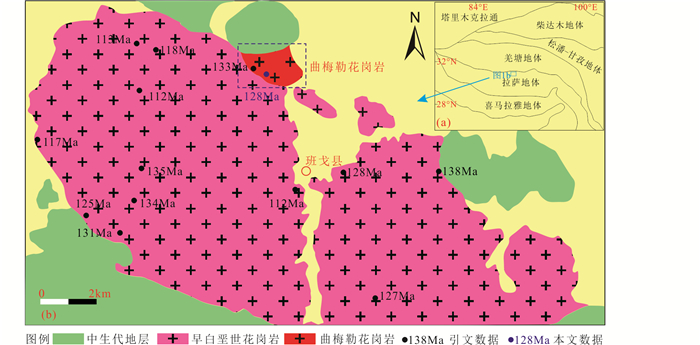
|
图 1 班戈地区区域地质简图 (b)据西藏自治区地质调查院, 2002①; 吉林省地质调查院, 2003②; 年龄数据高顺宝等, 2011; Haider et al., 2013; Volkmer et al., 2014; Zhu et al., 2016 Fig. 1 Distribution of Early Paleozoic granites and geological sketch map of Baingoin area Age data sources: Gao et al., 2011; Haider et al., 2013; Volkmer et al., 2014; Zhu et al., 2016 |
① 西藏自治区地质调查院. 2002. 1:25万班戈县幅区域地质图
② 吉林省地质调查院. 2003. 1:25万多巴区幅区域地质图
曲梅勒岩体位于班戈县城NNW方向5km左右,呈岩株状产出,出露面积较小(图 1b、图 2a)。1:25万多巴幅地质调查中,前人认为曲梅勒岩体侵入于SE方向的早白垩世班戈岩体,并且北部为古-始新统牛堡组砂岩不整合覆盖(吉林省地质调查院, 2003)。本次1:5万区域地质调查过程中,未见与班戈岩体石英闪长岩部分直接接触关系,根据锆石U-Pb定年结果,推测石英闪长岩时代晚于曲梅勒岩体。此外,曲梅勒岩体与北侧下白垩统多尼组(原古新统-始新统牛堡组)出露砂岩的接触界面见明显烘烤面及角岩化现象,推测北侧地层早于曲梅勒岩体。岩石外表中-轻度风化,节理较为发育,新鲜面为灰白色(图 2b)。岩性为二长花岗岩,少量钾长石和斜长石斑晶,其余为中-粗粒石英(30%)+斜长石(30%)+钾长石(35%),以及少量黑云母和白云母,金属矿物少见(图 2c, d)。其中石英呈他形粒状充填在长石间隙中,波状消光普遍,裂隙发育;斜长石自形程度较高,聚片双晶发育,多绢云母化;钾长石多呈短柱状,主要为条纹长石和正长石,见简单双晶,普遍有较弱的泥化现象;黑云母半自形片状,解理发育,部分蚀变为白云母,见少量含铁质等成分沿解理缝析出;白云母多呈细小片状分布在斜长石等矿物颗粒中。此外,还可见锆石、榍石和磁铁矿等副矿物。
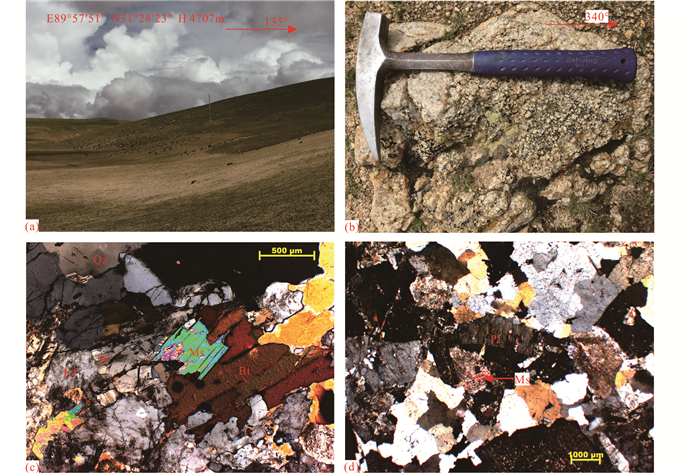
|
图 2 班戈地区曲梅勒花岗岩野外(a、b)及显微镜下(c、d)照片 Kf-钾长石;Pl-斜长石;Qz-石英;Bt-黑云母;Ms-白云母 Fig. 2 Outcrops (a, b) and photomicrographs (c, d) of Qumeile granite in Baingoin area Kf-K-feldspar; Pl-plagioclase; Qz-quartz; Bt-biotite; Ms-muscovite |
锆石样品的分选、制靶和阴极发光(CL)图像在北京锆年领航科技有限公司实验室完成。样品破碎至80~120目,经淘洗粉尘、去除磁性矿物、重液分选等程序;在双目体视显微镜下随机挑选一定数量的锆石颗粒粘在双面胶上,然后以低温环氧树脂浇铸,然后在自动抛光机上对锆石表面进行抛光,并依次用酒精、洗涤剂和水在超声波中对靶表面进行清洗。制靶完成后先在偏光显微镜下按最宽视域依次进行透射光和反射光照相,然后对锆石靶进行镀金处理,CL图像是在配备了英国Gatan阴极荧光探头的日本电子JSM6510型电子显微镜采集的。
测试分析在中国地质科学院国家地质实验测试中心完成。锆石U-Pb定年工作所用的激光系统为美国New Wave公司生产的钇铝榴石系统,波长为213nm,束斑直径可调。质谱仪为Thermo Element XR。激光剥蚀采样过程以氦气作为载气,氦气携带样品气溶胶在进入ICP之前通过一个T型三通接头与氩气(载气、等离子体气和补偿气)混合。通过调节氦气和氩气气流大小,以获得NIST SRM 612(美国国家标准技术研究院研制的人工合成硅酸盐玻璃标准参考物质)最佳信号为条件实现测试系统最优化。优化条件主要为信号灵敏度最高、氧化物产率最低、双电荷干扰最小、气体空白最低和信号强度最稳定。在束斑直径为35μm、频率为10Hz、能量密度约为8J/cm2激光剥蚀条件下,线扫描方式剥蚀NIST SRM 612可获得:232Th灵敏度可达2×105cps/ppm;氧化物产率ThO/Th < 0.3%。每个样品同时测试202Hg、204Pb、206Pb、207Pb、208Pb、232Th、235U、238U等同位素,样品测试时采样方式为单点剥蚀、跳峰采集;单点采集时间模式为:20s气体空白+40s样品剥蚀+20s冲洗;每10个未知样品点插入一组标样。GJ-1作为外标进行数据校正,Plesovice用于数据质量监控,数据处理采用Glitter软件。
2.2 主、微量元素分析本项研究所选新鲜样品的岩石粉末碎样、化学全分析工作澳实分析检测(广州)有限公司完成。氧化物用X荧光光谱仪(XRF)测试,试样加入包含硝酸锂在内的助熔剂,充分混合后,高温熔融。熔融物倒入铂金模子形成扁平玻璃片后,再用X荧光光谱仪分析。同时称取另一份试样放入马弗炉中,于1000℃加热1小时。冷却后称重。样品加热前后的重量差即是烧失量。FeO经硫酸和氢氟酸消解后测定,试样倒入装有稀硫酸或磷酸、硼酸溶液的烧杯中,用重铬酸钾溶液滴定。稀土元素和微量元素试样称取两份,一份试样用高氯酸、硝酸、氢氟酸消解。蒸至近干后的样品用稀盐酸溶解定容,再用等离子体发射光谱与等离子体质谱进行分析。另一份试样加入到偏硼酸锂/四硼酸锂熔剂中,混合均匀,在1025℃以上的熔炉中熔化。熔液冷却后,用硝酸、盐酸和氢氟酸定容,再用等离子体质谱仪分析。根据样品的实际情况和消解效果,综合取值即是最后的检测结果。
2.3 LA-ICP-MS Hf同位素锆石Hf同位素的分析是在前述锆石U-Pb同位素基础上完成的,测试在中国地质科学院地质研究所Neptune Plus型多接收等离子质谱和GeoLasPro 193nm激光剥蚀系统(LA-MC-ICP-MS)上进行的,实验过程中采用He作为剥蚀物质载气,根据锆石大小,剥蚀直径采用44μm,测定时使用锆石国际标样GJ-1作为参考物质。相关仪器运行条件及详细分析流程见侯可军等(2007)。分析过程中锆石标准GJ-1的176Hf/177Hf测试加权平均值分别为0.282007±0.000025(2σ)。计算初始176Hf/177Hf时,Lu的衰变常数采用1.865×10-11y-1(Scherer et al., 2001),εHf(t)值的计算时采用球粒陨石Hf同位素值176Lu/177Hf=0.0336,176Hf/177Hf=0.282785(Bouvier et al., 2008)。在Hf的地幔模式年龄计算中,亏损地幔176Hf/177Hf现在值采用0.28325,176Lu/177Hf采用0.0384(Griffin et al., 2000),地壳模式年龄计算时采用平均地壳的176Lu/177Hf=0.015(Griffin et al., 2002)。
3 分析结果 3.1 LA-ICP-MS锆石U-Pb定年用于进行锆石U-Pb定年的样品号为17BGA31-3。阴极发光图像中,该样品中锆石多呈灰白色,主要为短柱状,少数呈长柱状,长度介于80~200μm之间,长宽比1.5:1~2:1;清晰岩浆振荡环带显示其可能为岩浆成因(图 3a)。此外,较亮的阴极发光图像表明锆石中U、Th和REE等微量元素含量不高(Hanchar and Miller, 1993; Rubatto and Gebauer, 2000)。测试结果显示,锆石中Th含量为26×10-6~1129×10-6,U含量为362×10-6~2084×10-6,Th/U比值平均为0.13(表 1),可能为岩浆成因(吴元保和郑永飞, 2004)。通过锆石内部的206Pb/238U进行加权平均年龄计算,该样品加权平均年龄为128±2Ma(MSWD=1.3, n=22)(图 3b, c)。此外,测点8、12和14的U-Pb年龄分别为360Ma、921Ma和400Ma,结合阴极发光图像分析,上述年龄可能来自于锆石捕虏晶。
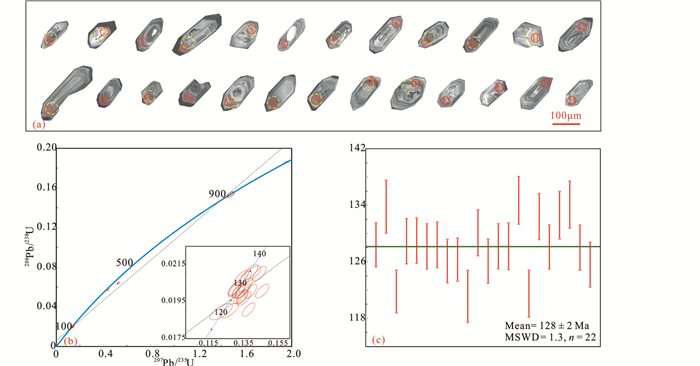
|
图 3 班戈地区曲梅勒花岗岩锆石阴极发光图像(a)、U-Pb谐和曲线(b)和加权平均年龄图(c) 图 3a中红色实线和黄色虚线分别代表LA-ICP-MS U-Pb定年和Hf同位素分析测点 Fig. 3 Cathodoluminescence (CL) images (a), U-Pb concordia (b) and weighted average age plots (c) of zircon grains from Qumeile granite in Baingoin area Red solid and yellow dashed circles indicate the locations of LA-ICP-MS U-Pb and Hf analyses in Fig. 3a, respectively |
|
|
表 1 班戈地区曲梅勒花岗岩锆石LA-ICP-MS U-Th-Pb数据 Table 1 LA-ICP-MS zircon U-Pb isotopic analyses for the samples of Qumeile granite in Baingoin area |
全岩地球化学数据结果见表 2。其SiO2含量为74.40%~76.67%,FeOT含量为0.61%~1.59%,Na2O含量为2.73%~2.89%,K2O含量为4.61%~4.83%,Na2O+K2O含量为7.49%~7.56%,Na2O/K2O比值为0.57~0.62(表 2)。根据SiO2-Na2O+K2O分类图(图 4a),全部样品落入了花岗岩区域内,根据SiO2-K2O图(图 4b),该花岗岩为高钾钙碱性系列。Al2O3含量为12.82%~13.74%,A/CNK为1.19~1.24,A/NK为1.31~1.41。在A/CNK-A/NK分类图(图 5),该花岗岩样品落入了过铝质区域,属强过铝质。总体上,具有高Si、K,富全碱,低Mg、Fe、Ca的特征。此外,曲梅勒花岗岩与中国部分具高分异特征的花岗质岩石在主量元素特征方面具有一定的相似性(图 4、图 5)。
|
|
表 2 班戈地区曲梅勒花岗岩主量(wt%)和微量(×10-6)元素含量 Table 2 Major (wt%) and trace (×10-6) elements compositions of Qumeile granite in Baingoin area |
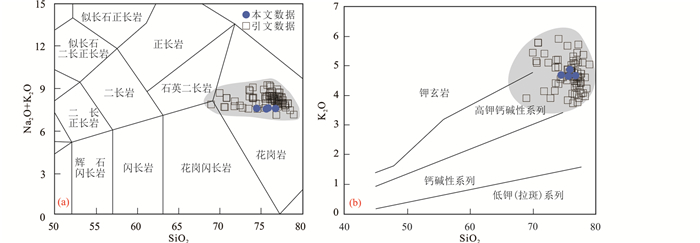
|
图 4 班戈地区曲梅勒花岗岩SiO2-(Na2O+K2O)图(a, 据Middlemost, 1994修改)和SiO2-K2O图(b, 据Martin et al., 2005修改) 引文数据来源:邱俭生等(2008); Jahn et al. (2001); Wu et al. (2003a); Zhu et al.(2009b, 2015); Tao et al. (2013).图 5、图 8、图 10、图 11、图 13、图 14中数据来源及图例同此图 Fig. 4 Whole-rock SiO2 vs. Na2O+K2O (a, after Middlemost, 1994) and SiO2 vs. K2O (b, after Martin et al., 2005) classification diagrams of the granite phases from Qumeile granite in Baingoin area Data sources: Qiu et al. (2008); Jahn et al. (2001); Wu et al. (2003a); Zhu et al.(2009b, 2015); Tao et al. (2013). Data sources and symbols in Fig. 5, Fig. 8, Fig. 10, Fig. 11, Fig. 13, Fig. 14 as in this figure |
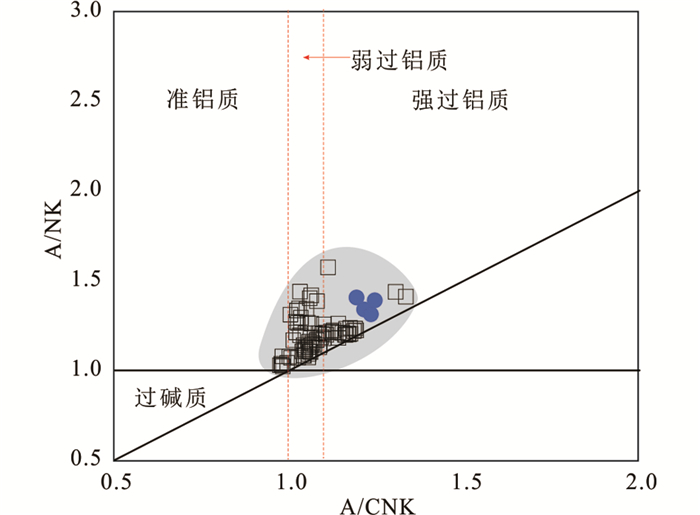
|
图 5 班戈地区曲梅勒花岗岩A/CNK-A/NK图(据Maniar and Piccoli, 1989) Fig. 5 A/CNK vs. A/NK diagram of Qumeile granite in Baingoin area (after Maniar and Piccoli, 1989) |
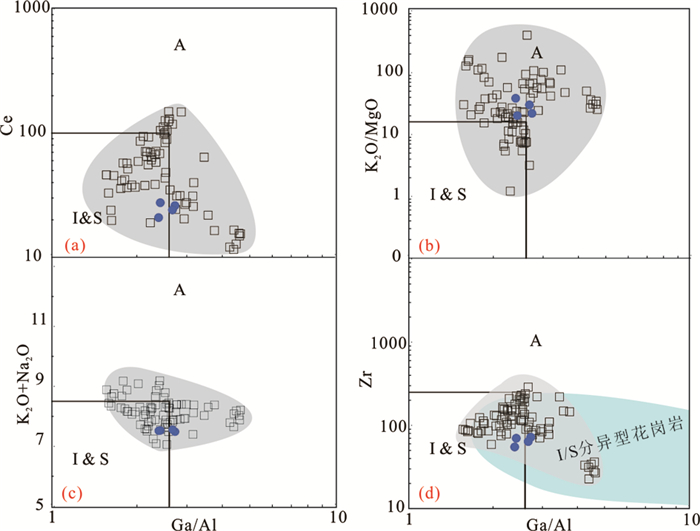
|
图 8 班戈地区曲梅勒花岗岩成因类型判别图解(据Whalen et al., 1987; d, I/S分异型花岗岩范围据Wu et al., 2017) Fig. 8 Discrimination diagrams of genetic type for Qumeile granite in Baingoin area (after Whalen et al., 1987; d, I/S-type fractionated granite data after Wu et al., 2017) |
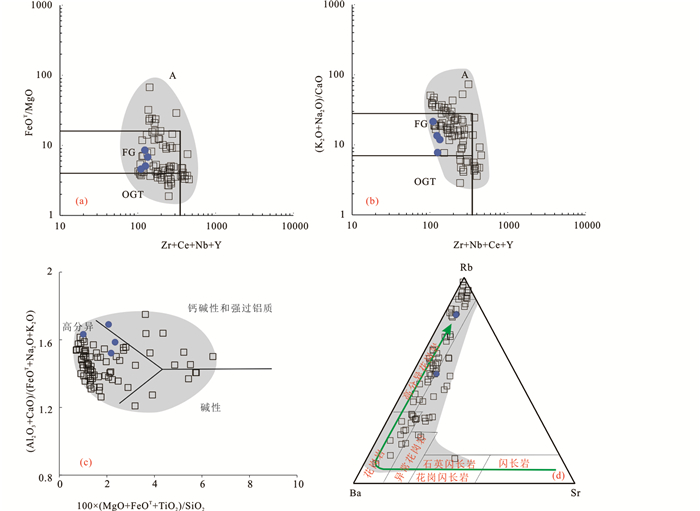
|
图 10 班戈地区曲梅勒高分异花岗岩判别图解(a, b, 据Whalen et al., 1987; c, 据Sylvester, 1989; d, 据Wang et al., 2013) FG-高分异I/S/M型花岗岩; OGT-非高分异I/S/M型花岗岩 Fig. 10 Discrimination diagrams for Qumeile highly-fractionated granite in Baingoin area (a, b, after Whalen et al., 1987; c, after Sylvester, 1989; d, after Wang et al., 2013) FG-fractionated I-, S-, and M-type granite; OGT-unfractionated I-, S-, and M-type granite |
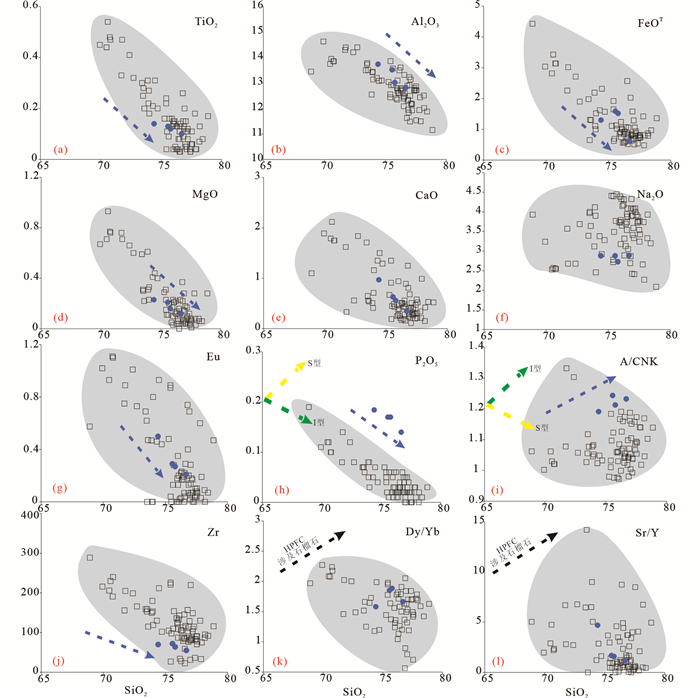
|
图 11 班戈地区曲梅勒花岗岩Harker图解 HPFC-高压条件下分离结晶 Fig. 11 Harker diagrams for Qumeile granite in Baingoin area HPFC-high-pressure fractional crystallization |
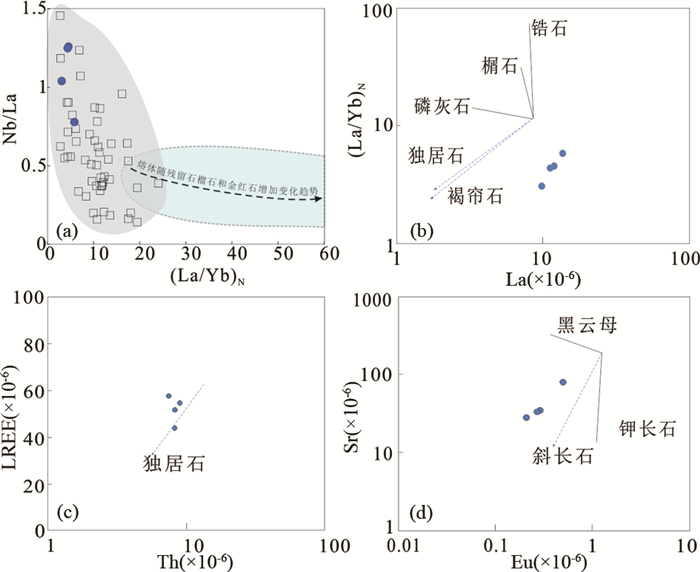
|
图 13 班戈地区曲梅勒花岗岩(La/Yb)N-Nb/La (a, 据Xiong et al., 2011)、La-(La/Yb)N (b, 据Li et al., 2017c)、Th-LREE (c, 据Li et al., 2017c)和Eu-Sr (d, 据Xiang et al., 2017)关系图 Fig. 13 Nb/La vs. (La/Yb)N (a, after Xiong et al., 2011), (La/Yb)N vs. La (b, after Li et al., 2017c), LREE vs. Th (c, after Li et al., 2017c) and Sr vs. Eu (d, after Xiang et al., 2017) diagrams for Qumeile granite in Baingoin area |
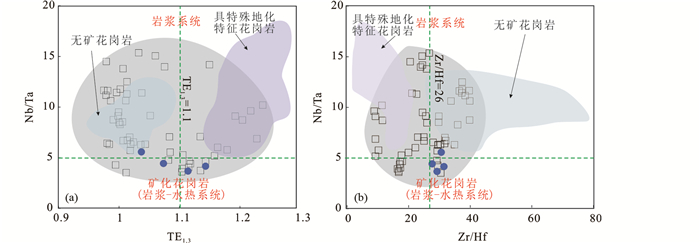
|
图 14 班戈地区曲梅勒花岗岩TE1, 3-Nb/Ta (a)和Zr-Hf-Nb/Ta (b)关系图(据Ballouard et al., 2016; Sami et al., 2018) Fig. 14 Nb/Ta vs. TE1, 3 (a) and Nb/Ta vs. Zr-Hf (b) diagrams for Qumeile granite in Baingoin area (after Ballouard et al., 2016; Sami et al., 2018) |
该花岗岩REE总量较低,为57×10-6~67×10-6(表 2),配分模式表现为轻稀土相对富集的右倾型(图 6a),其中轻重稀土LREE/HREE比值为3.32~5.89,(La/Yb)N为3.07~5.84,表明轻重稀土之间分馏程度较低(表 2)。(La/Sm)N为2.63~3.51,(Gd/Lu)N为1.07~1.38,反映了LREE和HREE元素内部分馏均不明显。此外,该类花岗岩具有中等-强烈的负Eu异常,Eu/Eu*为0.24~0.62。微量元素蛛网图中,该花岗岩主要富集大离子亲石元素(LILEs)Rb、Th、U和K等,相对亏损高场强元素(HFSEs),并且在Ba、Nb、Ta、P和Ti等元素上表现出了明显的负异常(图 6b)。

|
图 6 班戈地区曲梅勒花岗岩全岩球粒陨石标准化稀土元素配分模式(a)和原始地幔标准化微量元素蛛网图(b)(标准化值据Sun and McDonough, 1989) Fig. 6 Chondrite-normalized REE patterns (a) and primitive-mantle normalized spiderdiagrams (b) for Qumeile granite in Baingoin area (normalization values after Sun and McDonough, 1989) |
此外,根据Miller et al. (2003)提出的锆元素饱和浓度温度计进行计算,该花岗岩的TZr为721~740℃,平均温度为731℃;根据Rapp and Watson (1986)和Montel (1993)提出的稀土元素饱和浓度温度计进行计算,该花岗岩的TREE为741~756℃,平均温度为751℃(表 2)。
3.3 Hf同位素特征对曲梅勒花岗岩中15颗已测U-Pb年龄的锆石进行原位Hf同位素分析。分析结果表明,176Hf/177Hf范围为0.282588~0.282781,对应的εHf(t)变化于-3.8~+2.0,根据锆石U-Pb年龄计算的二阶段模式年龄(tDM2)变化于997~1426Ma之间(表 3、图 7),可能代表其壳幔分异作用时代(吴福元等, 2007b)。
|
|
表 3 班戈地区曲梅勒花岗岩锆石Lu-Hf同位素数据 Table 3 LA-ICP-MS zircon Hf isotopic analyses for the samples of Qumeile granite in Baingoin area |

|
图 7 班戈地区曲梅勒花岗岩锆石εHf(t)频率直方图(a)、tDM2频率直方图(b)和Hf同位素组成(c,据Zhu et al., 2011) Fig. 7 Histograms of εHf(t) (a) and tDM2 (b), and Hf isotopic compositions (c, after Zhu et al., 2011) of zircons from Qumeile granite in Baingoin area |
角闪石、堇青石和碱性暗色矿物是判断花岗岩类岩石成因类型的直接证据,曲梅勒花岗岩镜下未见上述标志性矿物,而在缺少矿物学证据的情况下,岩石地球化学便成了良好的指标(Pitcher, 1997)。花岗岩岩石类型判别图解(Ce、K2O/MgO、K2O+Na2O及Zr对104×Ga/Al)中(图 8),曲梅勒花岗岩因其较高的Ga/Al值,样品落入了A型花岗岩和靠近A型花岗岩的区域内(Whalen et al., 1987)。但是,A型花岗岩与SiO2>72%的I-/S-型高分异花岗岩,由于矿物组合和化学成分都趋近于最低共熔点组分,往往在地球化学特征上表现出一定的相似性(Whalen et al., 1987; King et al., 1997; Wu et al., 2003a, b)。而曲梅勒花岗岩高SiO2和全碱含量,低Fe、Mg和Ca含量以及低K/Rb比值,富集Rb、Th、U和Pb,亏损Ba、P和Ti等特征(图 6、表 2),均暗示其可能属于高分异花岗岩(Blevin and Chappell, 1992; Chappell and White, 1992; Sawka et al., 1990; Sylvester, 1998; Foley et al., 2000; Clemens, 2003; Xiong et al., 2005; Xiao et al., 2014; Qiu et al., 2017)。并且单阶段的部分熔融无法产生具低Sr(< 100×10-6)和高Rb含量的花岗岩,因此曲梅勒岩体很可能经历了强烈的分离结晶作用(Halliday et al., 1991; Sami et al., 2018)。
曲梅勒花岗岩具有较低的Ba、Zr、Y、Nb、La和Ce含量,相对较低的锆元素饱和浓度温度(Miller et al., 2003; 721~740℃; 表 2),以及亏损高场强元素的特征,也与A型花岗岩的特点明显不同(Whalen et al., 1987; Bonin, 2007; Dall’Agnol and de Oliveira, 2007),同时,Li、Rb和Cs含量的显著增高则表明该岩体更倾向于属于高分异岩石(Gelman et al., 2014; Lee and Morton, 2015)。K/Rb、Zr/Hf、Nb/Ta和Y/Ho等地球化学行为一致元素的比值在一般的岩浆体系中并不发生数值的变化(Green, 1995; Wu et al., 2017),但当岩浆由于分异而发生性质上的明显改变时,这些比值都将显著变小(Bau, 1996; Dostal and Chatterjee, 2000; Linnen and Keppler, 2002; Claiborne et al., 2006; Dostal et al., 2015; Ballouard et al., 2016; Deering et al., 2016)。曲梅勒花岗岩较低的分异程度相关参数也明显低于球粒陨石,暗示其经历了较高程度的分异(图 9)。而在主量和微量元素方面,曲梅勒花岗岩也与高分异花岗岩表现出了较强的相似性(图 4、图 5、图 6)。结合高分异花岗岩判别图解以及较高的分异指数(DI=90.5~94.9,通过CIPW计算)综合判断(图 10),曲梅勒花岗岩属于高分异花岗岩。
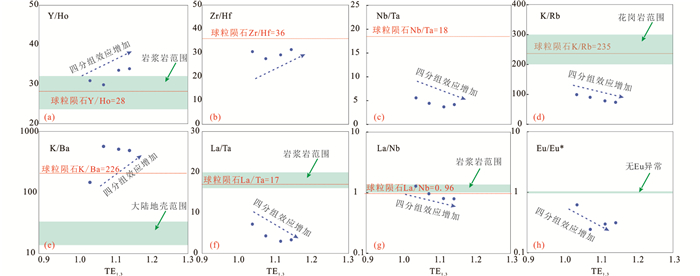
|
图 9 班戈地区曲梅勒花岗岩关键元素比值 TE1, 3=(TE1×TE3)0.5,TE1=(Ce/Ce*×Pr/Pr*)0.5,TE3=(Tb/Tb*×Dy/Dy*)0.5(Irber, 1999).球粒陨石引自Sun and McDonough (1989),岩浆岩范围、花岗岩范围和大陆地壳范围引自Jiang et al. (2016) Fig. 9 Variations in several key elemental ratios as indicators of differentiation from Qumeile granite in Baingoin area TE1, 3=(TE1×TE3)0.5, TE1=(Ce/Ce*×Pr/Pr*)0.5, TE3=(Tb/Tb*×Dy/Dy*)0.5 (Irber, 1999). Chondrite data from Sun and McDonough (1989), range data of magmatic rocks, granitoids and continental rocks from Jiang et al. (2016) |
过铝质花岗岩通常被认为是(变)沉积岩部分熔融的产物(S型花岗岩)(Chappell and White, 1974; Barbarin, 1996; Collins, 1998; Douce and Harris, 1998; Sylvester, 1998; Patiño Douce, 1999; Healy et al., 2004),曲梅勒花岗岩具强过铝质特征(A/CNK=1.19~1.24),并被认为是S型花岗岩(吉林省地质调查院, 2003)。但近年地球化学和实验岩石学研究均表明,I型花岗岩也可以具有过铝质甚至是强过铝质特征(Beard and Lofgren, 1991; Chappell, 1999; Sisson et al., 2005; Chappell et al., 2012)。近年来磷灰石溶解度实验表明,SiO2-P2O5相关关系可作为判断初始岩浆类型的重要指标,磷灰石在I型花岗岩中含量较低且与SiO2呈负相关关系,而在S型花岗岩中呈相反趋势(Chappell and White, 1992; Wolf and Wyllie, 1994; Chappell, 1999; Wu et al., 2003a, b)。由于不同包晶矿物的夹带作用,I型花岗岩被认为随着SiO2的增加而从准铝质向过铝质转变,而S型花岗岩的A/CNK值则维持常数或轻微降低(Clemens and Stevens, 2012; Gao et al., 2016)。曲梅勒花岗岩在上述相关特征方面均与I型花岗岩更为接近(图 11h)。此外,Rb-Th关系暗示该岩体具有I型花岗岩的地化特征(Chappell, 1999)(图 12)。因此,根据地球化学结果,曲梅勒花岗岩为高分异I型花岗岩。
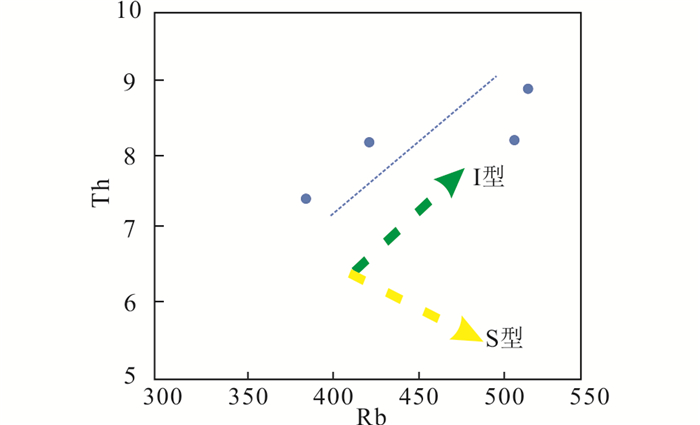
|
图 12 班戈地区曲梅勒花岗岩Rb-Th关系图(据Chappell, 1999) Fig. 12 Th vs. Rb diagrams for Qumeile granite in Baingoin area (after Chappell, 1999) |
高分异花岗岩的属性表明曲梅勒岩体在岩浆演化过程中可能发生了部分矿物的分离结晶作用,因此全岩主量和微量数据已无法反映初始岩浆特征,而同位素数据则受此影响较小,因此需要通过结合野外、镜下以及同位素数据来判断岩石成因。幔源岩浆分异成因的花岗岩往往需要其九倍体积的镁铁质岩浆,而岩体附近区域内缺少如此大面积出露的镁铁质岩浆活动证据(Turner et al., 1992; Winter, 2013)。此外,幔源岩浆通常在地壳中居留时间较短,因此锆石具有正的εHf(t),而曲梅勒岩体中锆石εHf(t)变化范围为-3.8~+2.0(图 7),负值εHf(t)也不支持其源于幔源岩浆分异的成因模式。壳幔岩浆发生混合经常导致镁铁质微粒包体的出现,并且会造成锆石εHf(t)变化范围较大,而曲梅勒花岗岩εHf(t)变化范围较为集中,反映了其岩浆来源较为均一,同时野外未见幔源暗色微粒包体,进一步排除了地幔物质的影响(Wang et al., 2018)。因此,野外及锆石Hf同位素共同表明,曲梅勒岩体来源于地壳物质的部分熔融,并且在岩浆演化过程中发生了较高程度的分离结晶。锆石二阶段模式年龄(tDM2)介于1.0~1.4Ga之间,表明曲梅勒花岗岩源岩时代可能是形成时代不晚于中元古代的(变)火成岩。
富Ti矿物中,只有金红石的残留会导致Nb/La的减小和(La/Yb)N的增加(Xiong et al., 2011),(La/Yb)N-Nb/La图解表明金红石并非源区的残留矿物(图 13a),因此,TiO2与SiO2的负相关关系以及Ti的亏损可能反映了富Ti矿物(如钛铁矿和金红石等)的分异(图 11a)。P2O5与SiO2的负相关以及P的亏损则可能是由于磷灰石的分异所致(图 11h)。而Zr元素随着岩浆演化而减少以及在微量元素蛛网图上表现出的亏损(图 6b、图 11j),则可能是由于锆石的分异作用(King et al., 1997)。此外,曲梅勒花岗岩中FeOT、MgO和CaO均与SiO2表现出了明显的负相关性,表明岩浆演化过程中镁铁矿物的分离结晶作用较为明显(图 11c-e)。镁铁矿物角闪石是赋存中稀土元素的重要矿物(李承东等, 2004),较为平坦的中稀土配分模式和大体相当的HoN和YbN值均暗示分离结晶过程中可能涉及了角闪石(图 5a)。此外,石榴石的分异通常会导致特殊的地球化学特征,如La与SiO2之间的负相关关系,而Dy/Yb和Sr/Y比值会随SiO2增加而增加(Castillo et al., 1999; Macpherson et al., 2006; Karsli et al., 2010),Dy/Yb和Sr/Y比值显示岩浆演化过程中石榴石的分异并不明显(图 11k, l),尽管La随着岩浆演化确实表现出了降低的趋势,这可能是由于褐帘石和独居石对稀土,特别是对轻稀土元素具有的较强控制作用所致,La-(La/Yb)N和Th-LREE的关系均反映了褐帘石和独居石的分异直接影响了曲梅勒岩体中LREE元素的含量(Bea, 1996; Li et al., 2017c)(图 13b, c)。同时,由于石榴石富集重稀土元素,而曲梅勒花岗岩稀土配分模式图中重稀土元素并未出现亏损,表明源区同样未发生石榴石的残留(Rapp and Watson, 1995)。Al2O3、Eu与SiO2表现出明显的相关性(图 11b, g),同时Sr、Ba和Eu均表现出了明显的负异常(图 6b),因此不能排除岩浆演化过程中发生过强烈的斜长石分离结晶作用(图 13d),而斜长石的分异会导致残余岩浆富Rb并具有较高的Rb/Sr比值。Na2O和K2O均未与SiO2表现出明显的线性关系(图 4b、图 11f),则表明碱性长石的分异作用并不强烈。而明显的稀土元素四分组效应(TE1-3=1.04~1.14)通常被认为是在岩浆发生高度分异后,熔体中出现大量流体,而流体与熔体之间的水-岩相互作用会改变岩浆中稀土元素的化学行为,致使呈现特殊的配分模式(赵振华等, 1992; Jahn et al., 2001; Monecke et al., 2011; Ballouard et al., 2016)。
总之,曲梅勒花岗岩在岩浆演化过程中可能发生了以部分镁铁矿物和斜长石为主的分异,同时伴有部分副矿物的分离结晶,而石榴石以及碱性长石未发生明显的分离结晶。
4.3 含矿性评价现有研究表明,诸多重要矿产与高分异花岗岩具有重要关联。如华南地区江西大湖塘W矿床,中亚造山带内蒙古东部的沙麦W矿床,泰国北部Khuntan岩基内的W-Sn矿床等(Jiang et al., 2016及相关文献);华南地区灵山复式岩体和雅山414岩体内的Nb-Ta矿(Yin et al., 1995; Xiang et al., 2017),南秦岭的梨园堂岩体内的Mo矿床等(Xiao et al., 2014)。前人研究表明,岩浆演化过程中的分离结晶作用在岩浆W-Sn-Nb-Ta元素的富集中起了重要作用(Jiang et al., 2016)。
Nb/Ta比值被视为区分无矿和矿化过铝质花岗岩的重要指标(Ballouard et al., 2016),并在埃及东部Eastern Desert地区的Abu-Diab含稀有金属白云母花岗岩和含石榴石白云母花岗岩有较好的应用(Sami et al., 2018)。曲梅勒花岗岩的Nb/Ta多数小于5,与岩浆-水热系统下的矿化花岗岩具有一定的相似性(图 14),与纯岩浆系统下的无矿花岗岩相比具有明显差别(Sami et al., 2018)。此外,曲梅勒花岗岩K/Rb含量比值小于100,Sr含量低于80×10-6,Ba含量同样低于80×10-6(除样品17BGA55-1外),并且具有明显的负Eu异常和REE四分组效应,上述这些较为特殊的地球化学特征表明强烈的岩浆/流体分馏过程在该岩体的形成过程中起了重要作用(Farahat et al., 2011)。过铝质花岗岩的全岩组成可受到岩浆演化晚期岩浆流体的改造,而使岩体具有良好的成矿条件(Ballouard et al., 2016)。因此,今后可加大投入寻找与该高分异花岗岩有关的矿床。
5 结论(1) 根据锆石U-Pb定年结果,北拉萨地块曲梅勒花岗岩形成时代为早白垩世(128Ma);地球化学数据表明其属于高钾钙碱性系列,并具强过铝质特征,具有明显的稀土元素四分组效应,且轻重稀土之间分馏程度较低;TZr和TREE平均温度分别为731℃和751℃;锆石Hf同位素显示其εHf(t)为-3.8~+2.0,tDM2变化于1.0~1.4Ga之间。
(2) 曲梅勒花岗岩属高分异I型花岗岩,其岩浆来源于地壳物质的部分熔融,并且在岩浆演化过程中可能发生了以部分镁铁矿物和斜长石为主的分异,同时伴有部分副矿物(磷灰石、锆石、独居石和富Ti矿物等)的分离结晶,而石榴石以及碱性长石未发生明显的分离结晶。
(3) 曲梅勒花岗岩较低的K/Rb和Nb/Ta比值、Sr和Ba含量等特征表明强烈的岩浆/流体分馏过程在该岩体的形成过程中起了重要作用,表明该岩体具有一定的成矿可能。
Ballouard C, Poujol M, Boulvais P, Branquet Y, Tartèse R and Vigneresse JL. 2016. Nb-Ta fractionation in peraluminous granites:A marker of the magmatic-hydrothermal transition. Geology, 44(3): 231-234 DOI:10.1130/G37475.1 |
Barbarin B. 1996. Genesis of the two main types of peraluminous granitoids. Geology, 24(4): 295-298 DOI:10.1130/0091-7613(1996)024<0295:GOTTMT>2.3.CO;2 |
Bau M. 1996. Controls on the fractionation of isovalent trace elements in magmatic and aqueous systems:Evidence from Y/Ho, Zr/Hf, and lanthanide tetrad effect. Contributions to Mineralogy and Petrology, 123(3): 323-333 DOI:10.1007/s004100050159 |
Bea F. 1996. Residence of REE, Y, Th and U in granites and crustal protoliths:Implications for the chemistry of crustal melts. Journal of Petrology, 37(3): 521-552 DOI:10.1093/petrology/37.3.521 |
Beard JS and Lofgren GE. 1991. Dehydration melting and water-saturated melting of basaltic and andesitic greenstones and amphibolites at 1, 3 and 6.9kb. Journal of Petrology, 32: 365-401 DOI:10.1093/petrology/32.2.365 |
Blevin PL and Chappell BW. 1992. The role of magma sources, oxidation states and fractionation in determining the granite metallogeny of eastern Australia. Earth and Environmental Science Transactions of the Royal Society of Edinburgh, 83(1-2): 305-316 DOI:10.1017/S0263593300007987 |
Bonin B. 2007. A-type granites and related rocks:Evolution of a concept, problems and prospects. Lithos, 97(1-2): 1-29 DOI:10.1016/j.lithos.2006.12.007 |
Bouvier A, Vervoort JD and Patchett PJ. 2008. The Lu-Hf and Sm-Nd isotopic composition of CHUR:Constraints from unequilibrated chondrites and implications for the bulk composition of terrestrial planets. Earth and Planetary Science Letters, 273(1-2): 48-57 DOI:10.1016/j.epsl.2008.06.010 |
Castillo PR, Janney PE and Solidum RU. 1999. Petrology and geochemistry of Camiguin Island, southern Philippines:Insights to the source of adakites and other lavas in a complex arc setting. Contributions to Mineralogy and Petrology, 134(1): 33-51 DOI:10.1007/s004100050467 |
Chappell BW and White AJR. 1974. Two contrasting granite types. Pacific Geology, 8(2): 173-174 |
Chappell BW and White AJR. 1992. I- and S-type granites in the Lachlan Fold Belt. Earth and Environmental Science Transactions of the Royal Society of Edinburgh, 83(1-2): 1-26 DOI:10.1017/S0263593300007720 |
Chappell BW. 1999. Aluminium saturation in I- and S-type granites and the characterization of fractionated haplogranites. Lithos, 46(3): 535-551 DOI:10.1016/S0024-4937(98)00086-3 |
Chappell BW, Bryant CJ and Wyborn D. 2012. Peraluminous I-type granites. Lithos, 153: 142-153 DOI:10.1016/j.lithos.2012.07.008 |
Claiborne LL, Miller CF, Walker BA, Wooden JL, Mazdab FK and Bea F. 2006. Tracking magmatic processes through Zr/Hf ratios in rocks and Hf and Ti zoning in zircons:An example from the Spirit Mountain batholith, Nevada. Mineralogical Magazine, 70(5): 517-543 DOI:10.1180/0026461067050348 |
Clemens JD. 2003. S-type granitic magmas:Petrogenetic issues, models and evidence. Earth-Science Reviews, 61(1-2): 1-18 DOI:10.1016/S0012-8252(02)00107-1 |
Clemens JD and Stevens G. 2012. What controls chemical variation in granitic magmas?. Lithos, 134-135: 317-329 DOI:10.1016/j.lithos.2012.01.001 |
Collins WJ. 1998. Evaluation of petrogenetic models for Lachlan Fold Belt granitoids:Implications for crustal architecture and tectonic models. Australian Journal of Earth Sciences, 45(4): 483-500 DOI:10.1080/08120099808728406 |
Dall'Agnol R and de Oliveira DC. 2007. Oxidized, magnetite-series, rapakivi-type granites of Carajás, Brazil:Implications for classification and petrogenesis of A-type granites. Lithos, 93(3-4): 215-233 DOI:10.1016/j.lithos.2006.03.065 |
Deering CD, Keller B, Schoene B, Bachmann O, Beane R and Ovtcharova M. 2016. Zircon record of the plutonic-volcanic connection and protracted rhyolite melt evolution. Geology, 44(4): 267-270 DOI:10.1130/G37539.1 |
Dostal J and Chatterjee AK. 2000. Contrasting behaviour of Nb/Ta and Zr/Hf ratios in a peraluminous granitic pluton (Nova Scotia, Canada). Chemical Geology, 163(1-4): 207-218 DOI:10.1016/S0009-2541(99)00113-8 |
Dostal J, Kontak DJ, Gerel O, Shellnutt JG and Fayek M. 2015. Cretaceous ongonites (topaz-bearing albite-rich microleucogranites) from Ongon Khairkhan, Central Mongolia:Products of extreme magmatic fractionation and pervasive metasomatic fluid:Rock interaction. Lithos, 236-237: 173-189 DOI:10.1016/j.lithos.2015.08.003 |
Douce AEP and Harris N. 1998. Experimental constraints on Himalayan anatexis. Journal of Petrology, 39(4): 689-710 DOI:10.1093/petroj/39.4.689 |
Fan JJ, Li C, Wu H, Zhang TY, Wang M, Chen JW and Xu JX. 2016. Late Jurassic adakitic granodiorite in the Dong Co area, northern Tibet:Implications for subduction of the Bangong-Nujiang oceanic lithosphere and related accretion of the southern Qiangtang terrane. Tectonophysics, 691: 345-361 DOI:10.1016/j.tecto.2016.10.026 |
Farahat ES, Zaki R, Hauzenberger C and Sami M. 2011. Neoproterozoic calc-alkaline peraluminous granitoids of the Deleihimmi pluton, Central Eastern Desert, Egypt:Implications for transition from late-to post-collisional tectonomagmatic evolution in the northern Arabian-Nubian Shield. Geological Journal, 46: 544-560 DOI:10.1002/gj.1289 |
Foley SF, Barth MG and Jenner GA. 2000. Rutile/melt partition coefficients for trace elements and an assessment of the influence of rutile on the trace element characteristics of subduction zone magmas. Geochimica et Cosmochimica Acta, 64(5): 933-938 DOI:10.1016/S0016-7037(99)00355-5 |
Gao P, Zheng YF and Zhao ZF. 2016. Distinction between S-type and peraluminous I-type granites:Zircon versus whole-rock geochemistry. Lithos, 258-259: 77-91 DOI:10.1016/j.lithos.2016.04.019 |
Gao SB, Zheng YY, Wang JS, Zhang Z and Yang C. 2011. The geochronology and geochemistry of intrusive rocks in Bange area:Constraints on the evolution time of the Bangong Lake-Nujiang ocean basin. Acta Petrologica Sinica, 27(7): 1973-1982 (in Chinese with English abstract) |
Gelman SE, Deering CD, Bachmann O, Huber C and Gutiérrez FJ. 2014. Identifying the crystal graveyards remaining after large silicic eruptions. Earth and Planetary Science Letter, 403: 299-306 DOI:10.1016/j.epsl.2014.07.005 |
Green TH. 1995. Significance of Nb/Ta as an indicator of geochemical processes in the crust-mantle system. Chemical Geology, 120(3-4): 347-359 DOI:10.1016/0009-2541(94)00145-X |
Griffin WL, Pearson NJ, Belousova E, Jackson SE, van Achterbergh E, O'Reilly SY and Shee SR. 2000. The Hf isotope composition of cratonic mantle:LAM-MC-ICPMS analysis of zircon megacrysts in kimberlites. Geochimica et Cosmochimica Acta, 64(1): 133-147 DOI:10.1016/S0016-7037(99)00343-9 |
Griffin WL, Wang X, Jackson SE, Pearson NJ, O'Reilly SY, Xu XS and Zhou XM. 2002. Zircon chemistry and magma mixing, SE China:In-situ analysis of Hf isotopes, Tonglu and Pingtan igneous complexes. Lithos, 61(3-4): 237-269 DOI:10.1016/S0024-4937(02)00082-8 |
Haider VL, Dunkl I, von Eynatten H, Ding L, Frei D and Zhang LY. 2013. Cretaceous to Cenozoic evolution of the northern Lhasa Terrane and the Early Paleogene development of peneplains at Nam Co, Tibetan Plateau. Journal of Asian Earth Sciences, 70-71: 79-98 DOI:10.1016/j.jseaes.2013.03.005 |
Halliday AN, Davidson JP, Hildreth W and Holden P. 1991. Modelling the petrogenesis of high Rb/Sr silicic magmas. Chemical Geology, 92(1-3): 107-114 DOI:10.1016/0009-2541(91)90051-R |
Hanchar JM and Miller CF. 1993. Zircon zonation patterns as revealed by cathodoluminescence and backscattered electron images:Implications for interpretation of complex crustal histories. Chemical Geology, 110(1-3): 1-13 DOI:10.1016/0009-2541(93)90244-D |
Hao LL, Wang Q, Wyman, DA, Ou Q, Dan W, Jiang ZQ, Wu FY, Yang JH, Long XP and Li J. 2016a. Underplating of basaltic magmas and crustal growth in a continental arc:Evidence from late Mesozoic intermediate-felsic intrusive rocks in southern Qiangtang, central Tibet. Lithos, 245: 223-242 DOI:10.1016/j.lithos.2015.09.015 |
Hao LL, Wang Q, Wyman DA, Ou Q, Dan W, Jiang ZQ, Yang JH, Li J and Long XP. 2016b. Andesitic crustal growth via mélange partial melting:Evidence from early Cretaceous arc dioritic/andesitic rocks in southern Qiangtang, central Tibet. Geochemistry, Geophysics, Geosystems, 17(5): 1641-1659 DOI:10.1002/2016GC006248 |
Healy B, Collins WJ and Richards SW. 2004. A hybrid origin for Lachlan S-type granites:The Murrumbidgee Batholith example. Lithos, 78(1-2): 197-216 DOI:10.1016/j.lithos.2004.04.047 |
Hou KJ, Li YH, Zou TR, Qu XM, Shi YR and Xie GQ. 2007. Laser ablation-MC-ICP-MS technique for Hf isotope microanalysis of zircon and its geological applications. Acta Petrologica Sinica, 23(10): 2595-2604 (in Chinese with English abstract) |
Irber W. 1999. The lanthanide tetrad effect and its correlation with K/Rb, Eu/Eu*, Sr/Eu, Y/Ho, and Zr/Hf of evolving peraluminous granite suites. Geochimica et Cosmochimica Acta, 63(3-4): 489-508 DOI:10.1016/S0016-7037(99)00027-7 |
Jahn BM, Wu FY, Capdevila R, Martineau F, Zhao ZH and Wang YX. 2001. Highly evolved juvenile granites with tetrad REE patterns:The Woduhe and Baerzhe granites from the Great Xing'an Mountains in NE China. Lithos, 59(4): 171-198 DOI:10.1016/S0024-4937(01)00066-4 |
Jiang SH, Bagas L, Hu P, Han N, Chen CL, Liu Y and Kang H. 2016. Zircon U-Pb ages and Sr-Nd-Hf isotopes of the highly fractionated granite with tetrad REE patterns in the Shamai tungsten deposit in eastern Inner Mongolia, China:Implications for the timing of mineralization and ore genesis. Lithos, 261: 322-339 DOI:10.1016/j.lithos.2015.12.021 |
Karsli O, Dokuz A, Uysal I·, Aydin F, Kandemir R and Wijbrans J. 2010. Generation of the Early Cenozoic adakitic volcanism by partial melting of mafic lower crust, Eastern Turkey:Implications for crustal thickening to delamination. Lithos, 114(1-2): 109-120 DOI:10.1016/j.lithos.2009.08.003 |
King PL, White AJR, Chappell BW and Allen CM. 1997. Characterization and origin of aluminous A-type granites from the Lachlan Fold Belt, southeastern Australia. Journal of Petrology, 38(3): 371-391 DOI:10.1093/petroj/38.3.371 |
Lee CTA and Morton DM. 2015. High silica granites:Terminal porosity and crystal settling in shallow magma chambers. Earth and Planetary Science Letters, 409: 23-31 DOI:10.1016/j.epsl.2014.10.040 |
Leier AL, DeCelles PG, Kapp PA and Gehrels GE. 2007. Lower cretaceous strata in the Lhasa terrane, Tibet, with implications for understanding the early tectonic history of the Tibetan Plateau. Journal of Sedimentary Research, 77(10): 809-825 DOI:10.2110/jsr.2007.078 |
Li CD, Zhang Q, Miao LC and Meng XF. 2004. Mesozoic high-Sr, low-Y and low-Sr, low-Y types granitoids in the northern Hebei Province:Geochemistry and petrogenesis and its relation to mineralization of gold deposits. Acta Petrologica Sinica, 20(2): 269-284 (in Chinese with English abstract) |
Li GM, Qin KZ, Li JX, Evans NJ, Zhao JX, Cao MJ and Zhang XN. 2017a. Cretaceous magmatism and metallogeny in the Bangong-Nujiang metallogenic belt, central Tibet:Evidence from petrogeochemistry, zircon U-Pb ages, and Hf-O isotopic compositions. Gondwana Research, 41: 110-127 DOI:10.1016/j.gr.2015.09.006 |
Li JX, Qin KZ, Li GM, Xiao B, Zhao JX, Cao MJ and Chen L. 2013. Petrogenesis of ore-bearing porphyries from the Duolong porphyry Cu-Au deposit, central Tibet:Evidence from U-Pb geochronology, petrochemistry and Sr-Nd-Hf-O isotope characteristics. Lithos, 160-161: 216-227 DOI:10.1016/j.lithos.2012.12.015 |
Li JX, Qin KZ, Li GM, Richards JP, Zhao JX and Cao MJ. 2014. Geochronology, geochemistry, and zircon Hf isotopic compositions of Mesozoic intermediate-felsic intrusions in central Tibet:Petrogenetic and tectonic implications. Lithos, 198-199: 77-91 DOI:10.1016/j.lithos.2014.03.025 |
Li JX, Qin KZ, Li GM, Xiao B, Zhao JX and Chen L. 2016b. Petrogenesis of Cretaceous igneous rocks from the Duolong porphyry Cu-Au deposit, central Tibet:Evidence from zircon U-Pb geochronology, petrochemistry and Sr-Nd-Pb-Hf isotope characteristics. Geological Journal, 51(2): 285-307 DOI:10.1002/gj.2631 |
Li SM, Zhu DC, Wang Q, Zhao ZD, Zhang LL, Liu SA, Chang QS, Lu YH, Dai JG and Zheng YC. 2016a. Slab-derived adakites and subslab asthenosphere-derived OIB-type rocks at 156±2Ma from the north of Gerze, central Tibet:Records of the Bangong-Nujiang oceanic ridge subduction during the Late Jurassic. Lithos, 262: 456-469 DOI:10.1016/j.lithos.2016.07.029 |
Li XH, Li ZX, Li WX, Liu Y, Yuan C, Wei GJ and Qi CS. 2007. U-Pb zircon, geochemical and Sr-Nd-Hf isotopic constraints on age and origin of Jurassic I- and A-type granites from central Guangdong, SE China:A major igneous event in response to foundering of a subducted flat-slab?. Lithos, 96(1-2): 186-204 DOI:10.1016/j.lithos.2006.09.018 |
Li XK, Li C, Sun ZM and Wang M. 2017b. Origin and tectonic setting of the giant Duolong Cu-Au deposit, South Qiangtang Terrane, Tibet:Evidence from geochronology and geochemistry of Early Cretaceous intrusive rocks. Ore Geology Reviews, 80: 61-78 DOI:10.1016/j.oregeorev.2016.06.025 |
Li YL, Zhang HF, Guo JH and Li CF. 2017c. Petrogenesis of the Huili Paleoproterozoic leucogranite in the Jiaobei Terrane of the North China Craton:A highly fractionated albite granite forced by K-feldspar fractionation. Chemical Geology, 450: 165-182 DOI:10.1016/j.chemgeo.2016.12.029 |
Linnen RL and Keppler H. 2002. Melt composition control of Zr/Hf fractionation in magmatic processes. Geochimica et Cosmochimica Acta, 66(18): 3293-3301 DOI:10.1016/S0016-7037(02)00924-9 |
Liu DL, Huang QS, Fan SQ, Zhang LY, Shi RD and Ding L. 2014. Subduction of the Bangong-Nujiang Ocean:Constraints from granites in the Bangong Co area, Tibet. Geological Journal, 49(2): 188-206 DOI:10.1002/gj.2510 |
Liu DL, Shi RD, Ding L, Huang QS, Zhang XR, Yue YH and Zhang LY. 2017. Zircon U-Pb age and Hf isotopic compositions of Mesozoic granitoids in southern Qiangtang, Tibet:Implications for the subduction of the Bangong-Nujiang Tethyan Ocean. Gondwana Research, 41: 157-172 DOI:10.1016/j.gr.2015.04.007 |
Liu S, Hu RZ, Gao S, Feng CX, Coulson IM, Feng GY, Qi YQ, Yang YH, Yang CG and Tang L. 2012. U-Pb zircon age, geochemical and Sr-Nd isotopic data as constraints on the petrogenesis and emplacement time of andesites from Gerze, southern Qiangtang Block, northern Tibet. Journal of Asian Earth Sciences, 45: 150-161 DOI:10.1016/j.jseaes.2011.09.025 |
Liu ZC, Wu FY, Ding L, Liu XC, Wang JG and Ji WQ. 2016. Highly fractionated Late Eocene (~35Ma) leucogranite in the Xiaru Dome, Tethyan Himalaya, South Tibet. Lithos, 240-243: 337-354 DOI:10.1016/j.lithos.2015.11.026 |
Macpherson CG, Dreher ST and Thirlwall MF. 2006. Adakites without slab melting:High pressure differentiation of island arc magma, Mindanao, the Philippines. Earth and Planetary Science Letters, 243(3-4): 581-593 DOI:10.1016/j.epsl.2005.12.034 |
Maniar PD and Piccoli PM. 1989. Tectonic discrimination of granitoids. GSA Bulletin, 101(5): 635-643 DOI:10.1130/0016-7606(1989)101<0635:TDOG>2.3.CO;2 |
Marignac C and Cuney M. 1999. Ore deposits of the French Massif Central:Insight into the metallogenesis of the Variscan collision belt. Mineralium Deposita, 34(5): 472-504 |
Martin H, Smithies RH, Rapp R, Moyen JF and Champion D. 2005. An overview of adakite, tonalite-trondhjemite-granodiorite (TTG), and sanukitoid:Relationships and some implications for crustal evolution. Lithos, 79(1-2): 1-24 DOI:10.1016/j.lithos.2004.04.048 |
Metcalfe I. 2011. Tectonic framework and Phanerozoic evolution of Sundaland. Gondwana Research, 19(1): 3-21 DOI:10.1016/j.gr.2010.02.016 |
Metcalfe I. 2013. Gondwana dispersion and Asian accretion:Tectonic and palaeogeographic evolution of eastern Tethys. Journal of Asian Earth Sciences, 66: 1-33 DOI:10.1016/j.jseaes.2012.12.020 |
Middlemost EAK. 1994. Naming materials in the magma/igneous rock system. Earth-Science Reviews, 37(3-4): 215-224 DOI:10.1016/0012-8252(94)90029-9 |
Miller CF, McDowell SM and Mapes RW. 2003. Hot and cold granites? Implications of zircon saturation temperatures and preservation of inheritance. Geology, 31: 529-532 DOI:10.1130/0091-7613(2003)031<0529:HACGIO>2.0.CO;2 |
Monecke T, Kempe U, Trinkler M, Thomas R, Dulski P and Wagner T. 2011. Unusual rare earth element fractionation in a tin-bearing magmatic-hydrothermal system. Geology, 39(4): 295-298 DOI:10.1130/G31659.1 |
Montel JM. 1993. A model for monazite/melt equilibrium and application to the generation of granitic magmas. Chemical Geology, 110(1-3): 127-146 DOI:10.1016/0009-2541(93)90250-M |
Pan GT, Mo XX, Hou ZQ, Zhu DC, Wang LQ, Li GM, Zhao ZD, Geng QR and Liao ZL. 2006. Spatial-temporal framework of the Gangdese Orogenic Belt and its evolution. Acta Petrologica Sinica, 22(3): 521-533 (in Chinese with English abstract) |
Patiño Douce AE. 1999. What do experiments tell us about the relative contributions of crust and mantle to the origin of granitic magmas? In: Castro A, Fernandez C and Vigneresse JL (eds.). Understanding Granites: Integrating New and Classical Techniques. Geological Society, London, Special Publications, 168: 55-75
|
Pitcher WS. 1997. The Nature and Origin of Granite. 2nd Edition. London: Chapman & Hall, 1-387
|
Qiu JS, Xiao E, Hu J, Xu XS, Jiang SY and Li Z. 2008. Petrogenesis of highly fractionated I-type granites in the coastal area of northeastern Fujian Province:Constraints from zircon U-Pb geochronology, geochemistry and Nd-Hf isotopes. Acta Petrologica Sinica, 24(11): 2468-2484 (in Chinese with English abstract) |
Qiu ZW, Yan QH, Li SS, Wang H, Tong LX, Zhang RQ, Wei XP, Li P, Wang LM, Bu A and Yan LM. 2017. Highly fractionated Early Cretaceous I-type granites and related Sn polymetallic mineralization in the Jinkeng deposit, eastern Guangdong, SE China:Constraints from geochronology, geochemistry, and Hf isotopes. Ore Geology Reviews, 88: 718-738 DOI:10.1016/j.oregeorev.2016.10.008 |
Qu XM, Wang RJ, Xin HB, Zhao YY and Fan XT. 2009. Geochronology and geochemistry of igneous rocks related to the subduction of the Tethys oceanic plate along the Bangong Lake arc zone, the western Tibetan Plateau. Geochimica, 38(6): 523-535 (in Chinese with English abstract) |
Rapp RP and Watson EB. 1986. Monazite solubility and dissolution kinetics:Implications for the Thorium and light rare earth chemistry of felsic magmas. Contributions to Mineralogy and Petrology, 94(3): 304-316 DOI:10.1007/BF00371439 |
Rapp RP and Watson EB. 1995. Dehydration melting of metabasalt at 8~32kbar:Implications for continental growth and crust-mantle recycling. Journal of Petrology, 36(4): 891-931 DOI:10.1093/petrology/36.4.891 |
Rubatto D and Gebauer D. 2000. Use of cathodoluminescence for U-Pb zircon dating by Ion Microprobe: Some examples from the western Alps. In: Pagel M, Barbin V, Blanc P and Ohnenstetter D (eds.). Cathodoluminescence in Geosciences. Berlin Heidelberg: Springer-Verlag, 373-400
|
Sami M, Ntaflos T, Farahat ES, Mohamed HA, Hauzenberger C and Ahmed AF. 2018. Petrogenesis and geodynamic implications of Ediacaran highly fractionated A-type granitoids in the North Arabian-Nubian Shield (Egypt):Constraints from whole-rock geochemistry and Sr-Nd isotopes. Lithos, 304-307: 329-346 DOI:10.1016/j.lithos.2018.02.015 |
Sawka WN, Heizler MT, Kistler RW and Chappell BW. 1990. Geochemistry of highly fractionated I- and S-type granites from the tin-tungsten province of western Tasmania. In: Stein HJ and Hannah JL (eds.). Ore-Bearing Granite Systems: Petrogenesis and Mineralizing Processes. Geological Society, London, Special Publication, 246: 161-180
|
Scherer E, Münker C and Mezger K. 2001. Calibration of the lutetium-hafnium clock. Science, 293(5530): 683-687 DOI:10.1126/science.1061372 |
Sisson TW, Ratajeski K, Hankins WB and Glazner AF. 2005. Voluminous granitic magmas from common basaltic sources. Contributions to Mineralogy and Petrology, 148(6): 635-661 DOI:10.1007/s00410-004-0632-9 |
Song Y, Tang JX, Qu XM, Wang DH, Xin HB, Yang C, Lin B and Fan SF. 2014. Progress in the study of mineralization in the Bangongco-Nujiang metallogenic belt and some new recognition. Advances in Earth Science, 29(7): 795-809 (in Chinese with English abstract) |
Song Y, Zeng QG, Liu HY, Liu ZB, Li HF and Dexi YZ. 2019. An innovative perspective for the evolution of Bangong-Nujiang Ocean:Also discussing the Paleo- and Neo-Tethys conversion. Acta Petrologica Sinica, 35(3): 625-641 (in Chinese with English abstract) DOI:10.18654/1000-0569/2019.03.02 |
Sun SS and McDonough WF. 1989. Chemical and isotopic systematics of oceanic basalts: Implications for mantle composition and processes. In: Saunders AD and Norry MJ (eds.). Magmatism in the Ocean Basins. Geological Society, London, Special Publication, 42(1): 313-345
|
Sylvester PJ. 1989. Post-collisional alkaline granites. The Journal of Geology, 97: 261-280 DOI:10.1086/629302 |
Sylvester PJ. 1998. Post-collisional strongly peraluminous granites. Lithos, 45(1-4): 29-44 DOI:10.1016/S0024-4937(98)00024-3 |
Tao JH, Li WX, Li XH and Cen T. 2013. Petrogenesis of Early Yanshanian highly evolved granites in the Longyuanba area, southern Jiangxi Province:Evidence from zircon U-Pb dating, Hf-O isotope and whole-rock geochemistry. Science China (Earth Sciences), 56(6): 922-939 DOI:10.1007/s11430-013-4593-6 |
Turner SP, Foden JD and Morrison RS. 1992. Derivation of some A-type magmas by fractionation of basaltic magma:An example from the Padthaway Ridge, South Australia. Lithos, 28(2): 151-179 DOI:10.1016/0024-4937(92)90029-X |
Volkmer JE, Kapp P, Horton BK, Gehrels GE, Minervini JM and Ding L. 2014. Northern Lhasa thrust belt of central Tibet: Evidence of Cretaceous-Early Cenozoic shortening within a passive roof thrust system? In: Nie JS, Horton BK and Hoke GD (eds.). Toward an Improved Understanding of Uplift Mechanisms and the Elevation History of the Tibetan Plateau. Geological Society, London, Special Publication, 507: 59-70
|
Wang N, Wu CL, Lei M and Chen HJ. 2018. Petrogenesis and tectonic implications of the Early Paleozoic granites in the western segment of the North Qilian orogenic belt, China. Lithos, 312-313: 89-107 DOI:10.1016/j.lithos.2018.04.023 |
Wang YJ, Xing XW, Cawood PA, Lai SC, Xia XP, Fan WM, Liu HC and Zhang FF. 2013. Petrogenesis of early Paleozoic peraluminous granite in the Sibumasu Block of SW Yunnan and diachronous accretionary orogenesis along the northern margin of Gondwana. Lithos, 182-183: 67-85 DOI:10.1016/j.lithos.2013.09.010 |
Whalen JB, Currie KL and Chappell BW. 1987. A-type granites:Geochemical characteristics, discrimination and petrogenesis. Contributions to Mineralogy and Petrology, 95(4): 407-419 DOI:10.1007/BF00402202 |
Winter JD. 2013. Principles of Igneous and Metamorphic Petrology. England: Pearson Education Limited
|
Wolf MB and Wyllie PJ. 1994. Dehydration-melting of amphibolite at 10kbar:The effects of temperature and time. Contributions to Mineralogy and Petrology, 115(4): 369-383 DOI:10.1007/BF00320972 |
Wu FY, Jahn BM, Wilde SA, Lo CH, Yui TF, Lin Q, Ge WC and Sun DY. 2003a. Highly fractionated I-type granites in NE China (Ⅰ):Geochronology and petrogenesis. Lithos, 66(3-4): 241-273 DOI:10.1016/S0024-4937(02)00222-0 |
Wu FY, Jahn BM, Wilde SA, Lo CH, Yui TF, Lin Q, Ge WC and Sun DY. 2003b. Highly fractionated I-type granites in NE China (Ⅱ):Isotopic geochemistry and implications for crustal growth in the Phanerozoic. Lithos, 67(3-4): 191-204 DOI:10.1016/S0024-4937(03)00015-X |
Wu FY, Li XH, Yang JH and Zheng YF. 2007a. Discussions on the petrogenesis of granites. Acta Petrologica Sinica, 23(6): 1217-1238 (in Chinese with English abstract) |
Wu FY, Li XH, Zheng YF and Gao S. 2007b. Lu-Hf isotopic systematics and their applications in petrology. Acta Petrologica Sinica, 23(2): 185-220 (in Chinese with English abstract) |
Wu FY, Liu ZC, Liu XC and Ji WQ. 2015. Himalayan leucogranite:Petrogenesis and implications to orogenesis and plateau uplift. Acta Petrologica Sinica, 31(1): 1-36 (in Chinese with English abstract) |
Wu FY, Liu XC, Ji WQ, Wang JM and Yang L. 2017. Highly fractionated granites:Recognition and research. Science China (Earth Sciences), 60(7): 1201-1219 DOI:10.1007/s11430-016-5139-1 |
Wu YB and Zheng YF. 2004. Genesis of zircon and its constraints on interpretation of U-Pb age. Chinese Science Bulletin, 49(15): 1554-1569 DOI:10.1007/BF03184122 |
Xiang YX, Yang JH, Chen JY and Zhang Y. 2017. Petrogenesis of Lingshan highly fractionated granites in the Southeast China:Implication for Nb-Ta mineralization. Ore Geology Reviews, 89: 495-525 DOI:10.1016/j.oregeorev.2017.06.029 |
Xiao B, Li QG, Liu SW, Wang ZQ, Yang PT, Chen JL and Xu XY. 2014. Highly fractionated Late Triassic I-type granites and related molybdenum mineralization in the Qinling orogenic belt:Geochemical and U-Pb-Hf and Re-Os isotope constraints. Ore Geology Reviews, 56: 220-233 DOI:10.1016/j.oregeorev.2013.07.003 |
Xiong XL, Adam J and Green TH. 2005. Rutile stability and rutile/melt HFSE partitioning during partial melting of hydrous basalt:Implications for TTG genesis. Chemical Geology, 218(3-4): 339-359 DOI:10.1016/j.chemgeo.2005.01.014 |
Xiong XL, Liu XC, Zhu ZM, Li Y, Xiao WS, Song MS, Zhang S and Wu JH. 2011. Adakitic rocks and destruction of the North China Craton:Evidence from experimental petrology and geochemistry. Science China (Earth Sciences), 54(6): 858-870 DOI:10.1007/s11430-010-4167-9 |
Xu ZQ, Dilek Y, Cao H, Yang JS, Robinson P, Ma CQ, Li HQ, Jolivet M, Roger F and Chen XJ. 2015. Paleo-Tethyan evolution of Tibet as recorded in the East Cimmerides and West Cathaysides. Journal of Asian Earth Sciences, 105: 320-337 DOI:10.1016/j.jseaes.2015.01.021 |
Yin A and Harrison TM. 2000. Geologic evolution of the Himalayan-Tibetan Orogen. Annual Review of Earth and Planetary Sciences, 28: 211-280 DOI:10.1146/annurev.earth.28.1.211 |
Yin L, Pollard PJ, Hu SX and Taylor RG. 1995. Geologic and geochemical characteristics of the Yichun Ta-Nb-Li deposit, Jiangxi Province, South China. Economic Geology, 90(3): 577-585 DOI:10.2113/gsecongeo.90.3.577 |
Zhang YX, Li ZW, Yang WG, Zhu LD, Jin X, Zhou XY, Tao G and Zhang KJ. 2017. Late Jurassic-Early Cretaceous episodic development of the Bangong Meso-Tethyan subduction:Evidence from elemental and Sr-Nd isotopic geochemistry of arc magmatic rocks, Gaize region, central Tibet, China. Journal of Asian Earth Sciences, 135: 212-242 DOI:10.1016/j.jseaes.2016.12.043 |
Zhao ZH, Masuda A and Shabani MB. 1992. Tetrad effects of rare-earth elements in rare-metal granites. Geochimica, (3): 221-233 (in Chinese with English abstract) |
Zhu DC, Pan GT, Mo XX, Wang LQ, Liao ZL, Zhao ZD, Dong GC and Zhou CY. 2006. Late Jurassic-Early Cretaceous geodynamic setting in middle-northern Gangdese:New insights from volcanic rocks. Acta Petrologica Sinica, 22(3): 534-546 (in Chinese with English abstract) |
Zhu DC, Mo XX, Niu YL, Zhao ZD, Wang LQ, Liu YS and Wu FY. 2009a. Geochemical investigation of Early Cretaceous igneous rocks along an east-west traverse throughout the central Lhasa Terrane, Tibet. Chemical Geology, 268(3-4): 298-312 DOI:10.1016/j.chemgeo.2009.09.008 |
Zhu DC, Mo XX, Wang LQ, Zhao ZD, Niu YL, Zhou CY and Yang YH. 2009b. Petrogenesis of highly fractionated I-type granites in the Zayu area of eastern Gangdese, Tibet:Constraints from zircon U-Pb geochronology, geochemistry and Sr-Nd-Hf isotopes. Science in China (Series D), 52(9): 1223-1239 DOI:10.1007/s11430-009-0132-x |
Zhu DC, Zhao ZD, Niu YL, Mo XX, Chung SL, Hou ZQ, Wang LQ and Wu FY. 2011. The Lhasa terrane:Record of a microcontinent and its histories of drift and growth. Earth and Planetary Science Letters, 301(1-2): 241-255 DOI:10.1016/j.epsl.2010.11.005 |
Zhu DC, Zhao ZD, Niu YL, Dilek Y, Hou ZQ and Mo XX. 2013. The origin and pre-Cenozoic evolution of the Tibetan Plateau. Gondwana Research, 23(4): 1429-1454 DOI:10.1016/j.gr.2012.02.002 |
Zhu DC, Li SM, Cawood PA, Wang Q, Zhao ZD, Liu SA and Wang LQ. 2016. Assembly of the Lhasa and Qiangtang terranes in central Tibet by divergent double subduction. Lithos, 245: 7-17 DOI:10.1016/j.lithos.2015.06.023 |
Zhu JC, Li RK, Li FC, Xiong XL, Zhou FY and Huang XL. 2001. Topaz-albite granites and rare-metal mineralization in the Limu District, Guangxi Province, Southeast China. Mineralium Deposita, 36(5): 393-405 DOI:10.1007/s001260100160 |
Zhu RZ, Lai SC, Qin JF and Zhao SW. 2015. Early-Cretaceous highly fractionated I-type granites from the northern Tengchong block, western Yunnan, SW China:Petrogenesis and tectonic implications. Journal of Asian Earth Sciences, 100: 145-163 DOI:10.1016/j.jseaes.2015.01.014 |
高顺宝, 郑有业, 王进寿, 张众, 杨成. 2011. 西藏班戈地区侵入岩年代学和地球化学:对班公湖-怒江洋盆演化时限的制约. 岩石学报, 27(7): 1973-1982. |
侯可军, 李延河, 邹天人, 曲晓明, 石玉若, 谢桂青. 2007. LA-MC-ICP-MS锆石Hf同位素的分析方法及地质应用. 岩石学报, 23(10): 2595-2604. DOI:10.3969/j.issn.1000-0569.2007.10.025 |
李承东, 张旗, 苗来成, 孟宪峰. 2004. 冀北中生代高Sr低Y和低Sr低Y型花岗岩:地球化学、成因及其与成矿作用的关系. 岩石学报, 20(2): 269-284. |
潘桂棠, 莫宣学, 侯增谦, 朱弟成, 王立全, 李光明, 赵志丹, 耿全如, 廖忠礼. 2006. 冈底斯造山带的时空结构及演化. 岩石学报, 22(3): 521-533. |
邱检生, 肖娥, 胡建, 徐夕生, 蒋少涌, 李真. 2008. 福建北东沿海高分异Ⅰ型花岗岩的成因:锆石U-Pb年代学、地球化学和Nd-Hf同位素制约. 岩石学报, 24(11): 2468-2484. |
曲晓明, 王瑞江, 辛洪波, 赵元艺, 樊兴涛. 2009. 西藏西部与班公湖特提斯洋盆俯冲相关的火成岩年代学和地球化学. 地球化学, 38(6): 523-535. DOI:10.3321/j.issn:0379-1726.2009.06.002 |
宋扬, 唐菊兴, 曲晓明, 王登红, 辛洪波, 杨超, 林彬, 范淑芳. 2014. 西藏班公湖-怒江成矿带研究进展及一些新认识. 地球科学进展, 29(4): 795-809. |
宋扬, 曾庆高, 刘海永, 刘治博, 李海峰, 德西央宗. 2019. 班公湖-怒江洋形成演化新视角:兼论西藏中部古-新特提斯转换. 岩石学报, 35(3): 625-641. |
吴福元, 李献华, 杨进辉, 郑永飞. 2007a. 花岗岩成因研究的若干问题. 岩石学报, 23(6): 1217-1238. |
吴福元, 李献华, 郑永飞, 高山. 2007b. Lu-Hf同位素体系及其岩石学应用. 岩石学报, 23(2): 185-220. |
吴福元, 刘志超, 刘小驰, 纪伟强. 2015. 喜马拉雅淡色花岗岩. 岩石学报, 31(1): 1-36. |
吴元保, 郑永飞. 2004. 锆石成因矿物学研究及其对U-Pb年龄解释的制约. 科学通报, 49(16): 1589-1604. DOI:10.3321/j.issn:0023-074X.2004.16.002 |
赵振华, 增田彰正, 夏巴尼 M.B.. 1992. 稀有金属花岗岩的稀土元素四分组效应. 地球化学, (3): 221-233. DOI:10.3321/j.issn:0379-1726.1992.03.003 |
朱弟成, 潘桂棠, 莫宣学, 王立全, 廖忠礼, 赵志丹, 董国臣, 周长勇. 2006. 冈底斯中北部晚侏罗世-早白垩世地球动力学环境:火山岩约束. 岩石学报, 22(3): 536-546. |
 2020, Vol. 36
2020, Vol. 36











